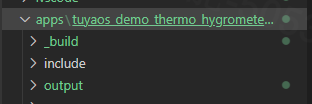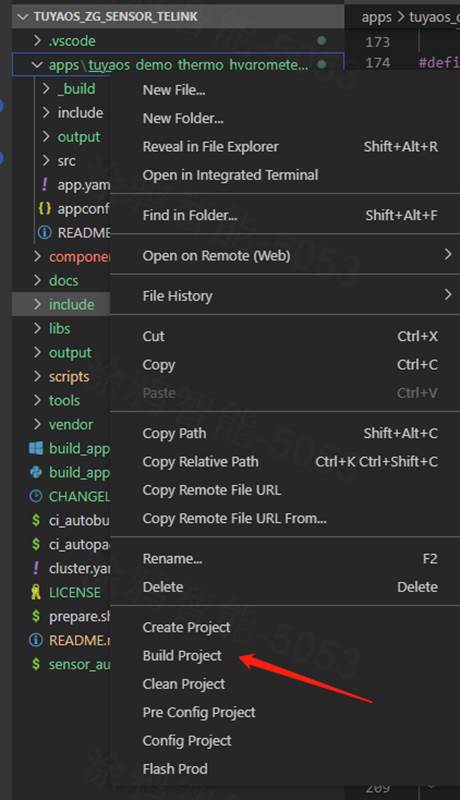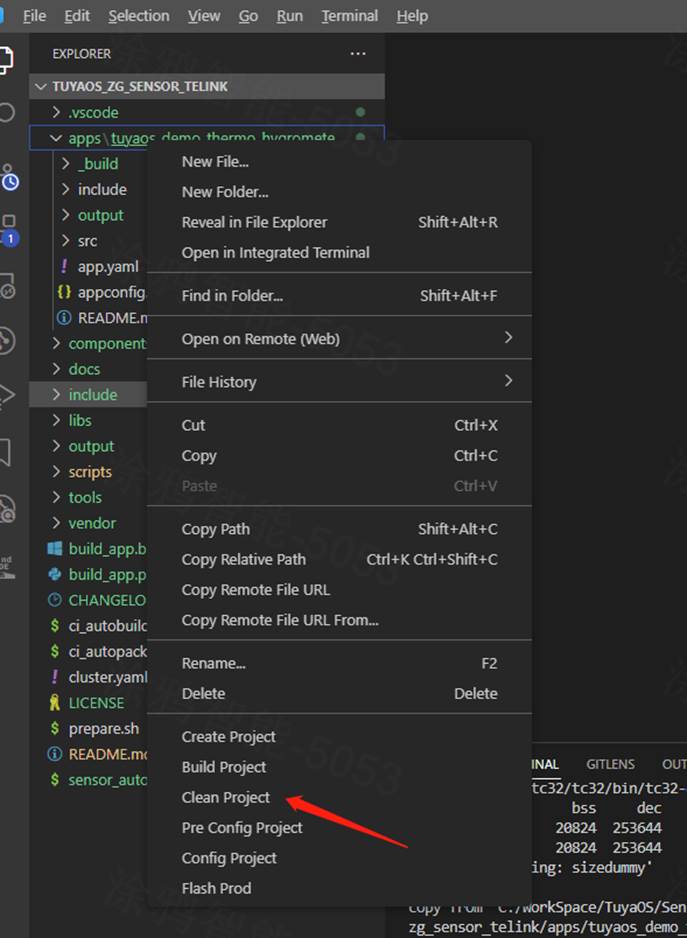Temperature and Humidity Sensor Product Development Kit
Last Updated on : 2024-08-06 14:34:53download
This topic describes a Zigbee temperature and humidity sensor demo built on top of the TuyaOS platform, featuring temperature and humidity reporting, support for multiple drivers, button control, status indicator, and battery level reporting.
Overview
Features
-
Measure temperature and humidity with the chosen sensor module.
-
Zigbee protocol: Wireless communication over Zigbee ensures reliable data transmission and stable connections.
-
Report temperature and humidity data to the gateway via Zigbee and display it on the app panel.
-
Compatible with various temperature and humidity sensor models.
-
Button control: Pair, wake up, and unpair the device using physical-button control.
-
Status indicator: An LED indicator signifies the connection and operating status.
-
Battery level reporting: Regularly report the battery level to help users know when to replace the battery.
Actions and behaviors
-
Device pairing
-
Press and hold the pairing button on the device for three seconds to trigger pairing mode, with the network indicator blinking quickly.
-
Pair the sensor with a gateway. See the Pairing Instructions.
-
When pairing succeeds, the network indicator stays on for three seconds before turning off, and the device appears in the mobile app.
-
When pairing times out (30 seconds by default), the network indicator stops blinking and goes to sleep.
-
-
Temperature and humidity data:
-
After the sensor is connected, activate the timer to regularly collect temperature and humidity readings.
-
After the sensor is connected, activate the timer to regularly report the current temperature and humidity readings.
-
When the sampling value exceeds the configurable threshold, the sensor will immediately report the current temperature and humidity.
-
-
Button actions:
-
Pressing the button turns on the network status indicator, while releasing it turns off the indicator and reports the battery level.
-
Pressing and holding the button turns on the network status indicator, while releasing it within three seconds turns off the indicator. When users press and hold the button for over three seconds, the device enters pairing mode, indicated by a rapid blinking light.
-
-
Status indication: The LED indicator behaves according to the device status and network connection.
-
When the device is powered on, the network indicator stays on for three seconds.
-
During pairing, the network indicator blinks quickly.
-
When pairing times out, the network indicator turns off.
-
When pairing succeeds, the network indicator stays on for three seconds and then turns off.
-
-
Battery level reporting:
-
Report the battery level at 100% within five seconds after successful pairing.
-
Report the actual battery level 20 minutes after successful pairing.
-
Report the current battery level every four hours.
-
When the battery level falls below 20%, report it every hour.
-
Create product
For more information about product creation, see Create Products.
Protocol details
Zigbee basics
| Parameter | Value |
|---|---|
| Profile ID | 0x0104 |
| Device ID | 0x0302 |
Endpoint
| Endpoint | Description |
|---|---|
| 1 | The endpoint of the current temperature and humidity sensor. |
Supported clusters
| Input clusters (server) | Output clusters (client) |
|---|---|
| Basic (0x0000) | OTA Upgrade (0x0019) |
| Power Configuration (0x0001) | / |
| Temperature Measurement (0x0402) | / |
| Relative Humidity Measurement (0x0405) | / |
Supported attributes and commands
Basic cluster
Attributes
| ID | Name | Data type (ID) | Range | Default |
|---|---|---|---|---|
| 0x0000 | ZCLVersion | uint8 (0x20) | 0x00 to 0xff | 0x03 |
| 0x0001 | ApplicationVersion | uint8 (0x20) | 0x00 to 0xff | For example, 0b 01 00 0001 indicates 1.0.1, that is, 0x41 represents version 1.0.1. This attribute is used for OTA updates. When an OTA update is initiated, the gateway reads the version number of the update and pushes it to the Zigbee device. After the Zigbee device is restarted after the update, the gateway reads the current version to check for the update result. The firmware can only be updated to a higher version. |
| 0x0002 | StackVersion | uint8 (0x20) | 0x00 to 0xff | 0x02 |
| 0x0003 | HWVersion | uint8 (0x20) | 0x00 to 0xff | 0x01 |
| 0x0004 | ManufacturerName | string (0x42) | 0 to 32 bytes | XXX…XXX. The value of this attribute is 16 bytes in length, consisting of an 8-byte prefix and 8-byte PID. 0 to 7 bytes: _TZ3000_. 8 to 16 bytes: The PID, the unique identifier of the Zigbee product you create on the Tuya Developer Platform. This field determines the UI and feature display on the mobile app. You can use the default PID if you do not require a custom one. |
| 0x0005 | ModelIdentifier | string (0x42) | 0 to 32 bytes | TY0201 |
| 0x0007 | PowerSource | enum8 (0x30) | 0x00 to 0xff | 0x03 |
| 0xFFFD | ClusterRevision | uint16 (0x21) | 0x0000 to 0xffff | 0x0001 |
Commands
| ID | Name | Direction |
|---|---|---|
| 0x00 | Reset to Factory Defaults | Client to server |
Power Configuration cluster
Attributes
| ID | Name | Data type (ID) | Range | Default |
|---|---|---|---|---|
| 0x0020 | BatteryVoltage | uint8 (0x20) | 0x00 to 0xff | 0x00 |
| 0x0021 | BatteryPercentageRemaining | uint8 (0x20) | 0x00 to 0xff | 0x00 |
| 0xFFFD | ClusterRevision | uint16 (0x21) | 0x0000 to 0xffff | 0x0001 |
Temperature Measurement cluster
Attributes
| ID | Name | Data type (ID) | Range | Default |
|---|---|---|---|---|
| 0x0000 | Measured value | int16 (0x29) | / | 0x00 |
| 0xFFFD | ClusterRevision | uint16 (0x21) | 0x0000 to 0xffff | 0x0001 |
Relative Humidity Measurement cluster
Attributes
| ID | Name | Data type (ID) | Range | Default |
|---|---|---|---|---|
| 0x0000 | Measured value | uint16 (0x21) | / | 0x00 |
| 0xFFFD | ClusterRevision | uint16 (0x21) | 0x0000 to 0xffff | 0x0001 |
OTA Upgrade cluster
Attributes
| ID | Name | Data type (ID) | Range | Default |
|---|---|---|---|---|
| 0x0000 | UpgradeServerID | EUI64 (0xF0) | / | 0xfffffffffffffffff |
| 0x0001 | FileOffset | uint32 (0x23) | / | 0x00000000 |
| 0x0002 | CurrentFileVersion | uint32 (0x23) | / | 0x00000000 |
| 0x0006 | ImageUpgradeStatus | enum8 (0x30) | / | 0x00 |
| 0x0007 | Manufacturer ID | uint16 (0x21) | / | 0x1002 |
| 0x0008 | Image Type ID | uint16 (0x21) | / | 0x1602 |
| 0x0009 | MinimumBlockPeriod | uint16 (0x21) | / | 0x0000 |
| 0xFFFD | ClusterRevision | uint16 (0x21) | 0x0000 to 0xffff | 0x0001 |
Commands
| ID | Name | Direction |
|---|---|---|
| 0x00 | Image Notify | Server to client |
| 0x01 | Query Next Image Request | Client to server |
| 0x03 | Image Block Request | Client to server |
| 0x06 | Upgrade End Request | Client to server |
Mapping between DPs and clusters
| DP ID | DP description | Standard command |
|---|---|---|
| 1 | Temperature | Yes |
| 2 | Humidity | Yes |
| 4 | Battery level | Yes |
DP1 Temperature
| Direction | Cluster ID | Attribute ID | Value |
|---|---|---|---|
| Device-to-cloud | 0x0402 | 0x0000 (Measured value) | 0x954d to 0x7fff |
DP4 Humidity
| Direction | Cluster ID | Attribute ID | Value |
|---|---|---|---|
| Device-to-cloud | 0x0405 | 0x0000 (Measured value) | 0 to 0x2710 |
DP5 Battery level
| Direction | Cluster ID | Attribute ID | Value |
|---|---|---|---|
| Device-to-cloud | 0x0001 | 0x0020 (BatteryVoltage) | 0x00 to 0xff |
| Device-to-cloud | 0x0001 | 0x0021 (BatteryPercentageRemaining) | 0x00 to 0xff |
If the reported value of 0x0020 is 30, it indicates a voltage of 3.0V. If the reported value of 0x0021 is 180, it indicates a battery level of 90%.
Default heartbeat
The heartbeat packet is sent every four hours by reporting the battery level.
For more information, see DP5 Battery level.
Build and flash firmware
Build firmware
-
Open your product development kit in Visual Studio Code and expand the
software/TuyaOS/appsfolder in the left navigation pane. The demoprojectfolder will appear.
-
Right-click the folder and choose Build Project. Enter the version number of the build in the format
x.x.x, and hit the Enter key to confirm.

-
Once the build is finished, the console will print the following information.

The build output is found in
apps/tuyaos_demo_thermo_hygrometer_t/output, where QIO is for production and UG is for an OTA update.
-
Clear the build cache. Before building the Telink firmware, it is recommended to select Clean Project, enter a version number, and then press Enter to clear the build cache.


Flash firmware
-
Use the chip vendor’s flashing tool, found in
TLSR8258_3.8.1\software\TuyaOS\docs\, to upload firmware to Telink chips. -
For more information about the flashing tools from Tuya and Silicon Labs, see Flash Firmware and Authorize Module.
Routine development
Configure basic information
Configure product features
You can configure the supported features in the sensor_app_config.h file within the include folder. To enable a feature, set it to 1. Otherwise, it is disabled. The product routine comes with essential features enabled by default and includes the necessary components. To implement the disabled features, contact the product manager. The following features are enabled for the temperature and humidity sensor by default:
#define APP_KEY_SUPPORT 1
#define APP_LED_SUPPORT 1
#define APP_BATTERY_SUPPORT 1
#define APP_GPIO_ALARM_SUPPORT 0
#define APP_IAS_ZONE_SUPPORT 0
#define APP_ILLUM_SUPPORT 0
#define APP_PIR_SUPPORT 0
#define APP_TEMPERATURE_HUMIDITY_SUPPORT 1
Configure device registration
In the app_dev_register.c file within the project’s src folder, you can modify the registered device information, including device ID, cluster, and attribute.
Add or remove the registered server cluster, as shown below.
// server cluster list
CONST TAL_CLUSTER_T app_server_cluster_list[] = {
DEF_CLUSTER_IDENTIFY_CLUSTER_ID(identify_attr_list)
DEF_CLUSTER_POWER_CLUSTER_ID(power_attr_list)
DEF_CLUSTER_IAS_ZONE_CLUSTER_ID(ias_zone_attr_list)
DEF_CLUSTER_TEMP_MEASUREMENT_CLUSTER_ID(temperature_attr_list)
DEF_CLUSTER_RELATIVE_HUMIDITY_MEASUREMENT_CLUSTER_ID(humidity_attr_list)
DEF_CLUSTER_ILLUM_MEASUREMENT_CLUSTER_ID(illum_measurement_attr_list)
DEF_CLUSTER_TUYA_SENSOR_CLUSTER_ID(tuya_sensor_server_attr_list)
};
Modify the registered endpoint and device ID, as shown below.
//endpoint descriptor
TAL_ENDPOINT_T dev_endpoint_desc[] = {
{1, ZHA_PROFILE_ID, ZG_DEVICE_ID_IAS_ZONE, SERVER_CLUSTER_NUM, (TAL_CLUSTER_T *)&app_server_cluster_list[0], 0, NULL},
};
Modify firmware information
In the app_config.yaml file within the project directory, configure information including the PID, model ID, and device type. Two configuration modes are available for this file. Choose the one that suits your needs. The content and function of the file are as follows:
#######################################################################
# COMPATIBILITY of [Tuya mode]
# For the use of Tuya redefined attributes:
# [cluster:0x0000,attribute:0x0004] Tuya manufacturer name
# [cluster:0x0000,attribute:0x0005] Tuya model ID
########################################################################
Firmware_Information:
description: "this is a demo project"
device_role: "router" # router/sleep_end_dev
image_type: 0x1602
manufacture_id: 0x1002
model_id: "TS0505B"
manufacture_name: "_TZ3210_hxyvqfuz" # capacity+pid
module_name: "ZSU"
chip_id: "efr32mg21a020f1024im32" # efr32mg21a020f1024im32/efr32mg21a020f768im32
########################################################################
# COMPATIBILITY of [Zigbee standard mode]
# For the use of ZCL standard attributes:
# [cluster:0x0000,attribute:0x0004] ManufacturerName
# [cluster:0x0000,attribute:0x0005] ModelIdentifier
########################################################################
# Firmware_Information:
# description: "this is a demo project"
# device_role: "router" # router/sleep_end_dev
# image_type: 0x1602
# manufacture_id: 0x1002
# model_id: "custom"
# manufacture_name: "custom"
# product_id: "bhzkbugw"
# capacity: "_TZ3210_"
# product_type: "TS0502B"
# module_name: "ZSU"
# chip_id: "efr32mg21a020f1024im32" # efr32mg21a020f1024im32/efr32mg21a020f768im32
To customize the model_id and manufacture_name attributes, you must select the second mode and specify capacity, product_type, and product_id.
| Name | Feature |
|---|---|
| description | The product description. |
| device_role | The device role, with router for a standard power router device and sleep_end_dev for a low power end device. Be cautious when making changes. |
| image_type | The firmware information, used to verify OTA updates. |
| manufacture_id | The manufacturer ID, used to verify OTA updates. |
| model_id | The device model, used to identify features after the device connects to a Tuya-enabled gateway. Be cautious when making changes. |
| manufacture_name | A value that combines the product capability value and Tuya’s PID, separated by an underscore (_), for example, _TZ3210_hxyvqfuz. |
| module_name | The module model, indicating which module the product uses. |
| chip_id | The chip model, indicating which chip the product uses. Do not change this field. |
| capacity | The capability value of a Tuya-enabled product. Do not change this field. If you do need to change this field, contact the product manager. |
| product_type | The device model, used to identify features after the device connects to a Tuya-enabled gateway. Be cautious when making changes. |
| product_id | The product ID (PID) assigned by Tuya. It is currently set to a default PID, which will be replaced with a new one during flashing. |
Configure components
The following lists the required components and their configuration.
Common component
Configure the common component tbl_common in the tbl_common.h file. The available options are as follows:
| Item | Feature |
|---|---|
| IAS_ZONE_ENDPOINT | The default endpoint for IAS Zone. It is recommended to leave it as is. |
| MANUFACTURER_CODE | The manufacturer code used for manual packet assembly and transmission. It is recommended to leave it as is. |
| IAS_ZONE_TYPE | IAS Zone Type. It is recommended to leave it as is. |
| DEFAULT_TX_POWER | The device’s transmit power. Change it based on your hardware. |
| BEACON_SEND_INTERVAL_200MS | The beacon transmission interval for network scanning. This option is usually unnecessary. |
| ZIGBEE_RESET_TIME_MS | The duration for pressing and holding the reset button, defaulting to three seconds. |
| ZIGBEE_JOIN_TIMEOUT_MS | The pairing timeout, defaulting to 30 seconds. |
Battery component for application layer
Configure the battery component tbl_battery in the tbl_battery_config.h file. The available options are as follows:
| Item | Feature |
|---|---|
| TBL_BAT_INFO_FIRST_RPT_REAL_VAL_TIME | The first time the actual battery level is reported after pairing, in milliseconds, defaulting to 20 minutes. |
| TBL_BAT_INFO_WAITTING_SILENCE_TIME | Not supported. No configuration required. |
| TBL_BAT_INFO_MAX_PERIOD_TIME | The frequency of battery level acquisition, in milliseconds, defaulting to one hour. |
| BATTTERY_HEARTBEAT_INTERVAL | The heartbeat interval, in milliseconds, defaulting to four hours. |
Battery component for adaptation layer
Configure the battery component tdl_battery in the tdl_battery_config.h file. The available options are as follows:
| Item | Feature |
|---|---|
| TDL_BATTERY_DRIVER_TYPE | The driver type for battery level acquisition. Only ADC sampling is supported. |
| TDL_BAT_INFO_ADC_PIN | The voltage acquisition pin. When internal sampling is selected, set this to 0. |
| TDL_BAT_INFO_ADC_CH_ID TDL_BAT_INFO_ADC_CH_LIST TDL_BAT_INFO_ADC_CH_NUM TDL_BAT_INFO_ADC_WIDTH TDL_BAT_INFO_ADC_FREQ TDL_BAT_INFO_ADC_MODE TDL_BAT_INFO_ADC_REF_VOL | ADC parameter configurations, which cannot be changed. |
| TDL_BAT_INFO_ADC_TYPE | The battery sampling type. When internal sampling is selected, the VCC supply voltage is measured. When external sampling is selected, the voltage on the acquisition pin is measured. |
| TDL_BAT_INFO_MIN_VOLT TDL_BAT_INFO_MAX_VOLT | The maximum and minimum voltage values. The component for Tuya’s business logic layer calculates the voltage-to-power conversion table accordingly. When both macros are set to 0, the default voltage-to-power conversion table is used. |
| BATTERY_DEFAULT_TABLE | The default voltage-to-power conversion table. |
Temperature and humidity component for application layer
Configure the temperature and humidity component tbl_temperature_humidity for the application layer in the tbl_temperature_humidity_config.h file. The available options are as follows:
| Item | Feature |
|---|---|
| MAX_TEMPERATURE | The maximum temperature value that can be collected. |
| MIN_TEMPERATURE | The minimum temperature value that can be collected. |
| TEMPERATURE_THESHOLD | Temperature threshold: When the temperature change exceeds this threshold, the device immediately reports the current temperature. |
| MAX_HUMIDITY | The maximum humidity value that can be collected. |
| MIN_HUMIDITY | The minimum humidity value that can be collected. |
| HUMIDITY_THESHOLD | Humidity threshold: When the humidity change exceeds this threshold, the device immediately reports the current humidity. |
| REGULAR_REPORT_INTERVAL | The frequency of reporting data, in seconds. |
| REGULAR_SAMPLE_INTERVAL | The frequency of sampling data, in seconds. |
Temperature and humidity component for adaptation layer
Configure the temperature and humidity component tdl_temperature_humidity for the adaptation layer in the tdl_temperature_humidity_config.h file. The available options are as follows:
| Item | Feature |
|---|---|
| TDL_TEMPERATURE_HUMIDITY_SENSOR_TYPE | The type of the temperature and humidity sensor driver. |
| TEMPERATURE_HUMIDITY_COMMUNICATION_IIC_INDEX | The I2C pin number for temperature and humidity measurement. When using multiple I2C sets simultaneously, ensure each set has a unique number. |
| TEMPERATURE_HUMIDITY_COMMUNICATION_IIC_SDA | The I2C SDA pin, configured based on your hardware. |
| TEMPERATURE_HUMIDITY_COMMUNICATION_IIC_SCL | The I2C SCL pin, configured based on your hardware. |
Configure pins
Configure buttons
Configure the button I/O pin in the sensor_app_config.h file within the product’s include folder, as shown below.
//key driver init info
#define KEY_PIN TUYA_GPIO_NUM_17
#define KEY_IRQ_MODE TUYA_GPIO_LEVEL_LOW
Configure indicators
Configure the indicator I/O pin in the sensor_app_config.h file within the product’s include folder, as shown below.
#define LED_SUM 2
#define LED_STATUS_PIN (UINT32_T)TUYA_GPIO_NUM_1
#define LED_STATUS_LEVEL LED_HIGH_ACTIVE
#define LED_STATUS_STATRT_STATE LED_ST_OFF
#define LED_STATUS_COMPLETE_CB (NULL) //Optional configuration
#define LED_NET_PIN (UINT32_T)TUYA_GPIO_NUM_0
#define LED_NET_LEVEL LED_HIGH_ACTIVE
#define LED_NET_STATRT_STATE LED_ST_OFF
#define LED_NET_COMPLETE_CB (NULL)
Configure component I/O
See Configure Components.
Pin mapping between Telink and Tuya
The pin mapping for the Telink platform is as follows. TUYA_GPIO_NUM_0 corresponds to PA0, and so on.
STATIC CONST UINT32_T tkl_gpio_list[] = {
GPIO_PA0, GPIO_PA1, GPIO_PA2, GPIO_PA3, GPIO_PA4, GPIO_PA5, GPIO_PA6, GPIO_PA7, // 0 - 7 //
GPIO_PB0, GPIO_PB1, GPIO_PB2, GPIO_PB3, GPIO_PB4, GPIO_PB5, GPIO_PB6, GPIO_PB7, // 8 - 15 //
GPIO_PC0, GPIO_PC1, GPIO_PC2, GPIO_PC3, GPIO_PC4, GPIO_PC5, GPIO_PC6, GPIO_PC7, // 16 - 23 //
GPIO_PD0, GPIO_PD1, GPIO_PD2, GPIO_PD3, GPIO_PD4, GPIO_PD5, GPIO_PD6, GPIO_PD7, // 24 - 31 //
GPIO_PE0, GPIO_PE1, GPIO_PE2, GPIO_PE3, // 32 - 35//
};
Pin mapping between Silicon Labs MG21 and Tuya
The pin mapping for the Silicon Labs MG21 is as follows. TUYA_GPIO_NUM_0 corresponds to PA0, and so on.
#define GPIO_PA0 0
#define GPIO_PA1 1
#define GPIO_PA2 2
#define GPIO_PA3 3
#define GPIO_PA4 4
#define GPIO_PA5 5
#define GPIO_PA6 6
#define GPIO_PB0 7
#define GPIO_PB1 8
#define GPIO_PC0 9
#define GPIO_PC1 10
#define GPIO_PC2 11
#define GPIO_PC3 12
#define GPIO_PC4 13
#define GPIO_PC5 14
#define GPIO_PD0 15
#define GPIO_PD1 16
#define GPIO_PD2 17
#define GPIO_PD3 18
#define GPIO_PD4 19
Support and help
If you have any problems with TuyaOS development, you can post your questions in the Tuya Developer Forum.
Is this page helpful?
YesFeedbackIs this page helpful?
YesFeedback





